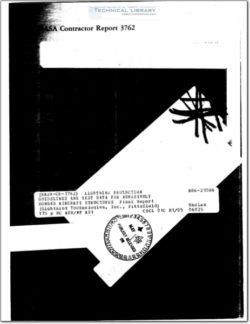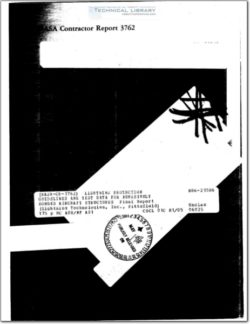NASA-CR-3762

- Version
- 220 Downloads
- 8.73 MB File Size
- 1 File Count
- May 19, 2016 Create Date
- May 19, 2016 Last Updated
Lightning Protection Guidelines for Adhesively Bonded Aircraft Structures

1.0 SUMMARY
The information presented in sections 2.0 and 3.0 of this
report were developed from electrical tests of groups of repre—
sentative Specimens of graphite/epoxy (gr/E) and adhesively
bonded aluminum. The purpose of the subelement program reported
in section 2.0 was to characterize the electrical performance of
typical structural bonds and joints and to determine the voltage
and/or current thresholds at which electrical sparking and loss
of physical strength occur. Then, complete, fully assembled
structures employing adhesive bonding techniques and other manu-
facturing concepts similar to those evaluated during the subele-
ment test program were tested to see if spark or physical damage
threshold conditions could be reached in typical structures.
These data are reported in Section 3.0. The data from both of
these experimental programs are intended for use by aircraft
designers in avoiding hazardous lightning effects in other de—
signs. Guidelines for use of this data and design of lightning
protection design are presented in Section 1.2.
Tests were performed on bonded aluminum and gr/E coupon-
type (sub-element) specimens to determine the dielectric voltage
breakdown and spark threshold levels of insulating adhesively
bonded specimens and the current spark threshold levels of elec-
trically conductive, adhesively bonded specimens. The aluminum
specimens included lap joint, fuel line bracket, stiffener and
honeycomb sections, and fuel tank access doors. gr/E specimens
included lap joint, stiffener, fuel line feed-through elbow, and
access door dome nut specimens in gr/E laminates.
Results of the bonded aluminum subelement specimens showed
that many of the bonded specimens were electrically conductive but
conductivity was not related to bond line thickness. The electri—
cally conductive specimens exhibited a wide scatter of current
spark threshold levels and many of the visible sparks were due to
burrs at the specimen edges and ends. Shear strength degradation
became significant at 2500 A/in2 except for specimens bonded with
an aluminum powder-filled adhesive which did not suffer appreciable
loss of strength at this current density. The addition of rivets
to the bonded specimens increased the spark threshold level by
400-900 percent above the level for non—riveted specimens.
For aluminum specimens with nonconductive bonds, a wide range
of voltage breakdown levels existed and most were due to edge
spark overs. The highest spark over voltages were exhibited by
specimens bonded with supported modified epoxies; the lowest read-
ings were obtained on specimens bonded with aluminum powder-filled
adhesives. Controlled bond line specimens showed increasing bond
line voltage thresholds for increasing bond line thickness.
| File | Action |
|---|---|
| NASA-CR-3762 Lightning Protection Guidelines for Adhesively Bonded Aircraft Structures.pdf | Download |

Comment On This Post